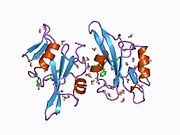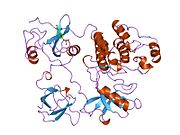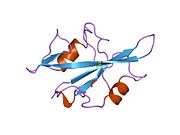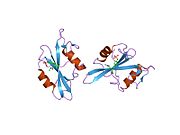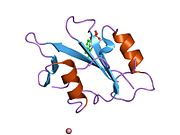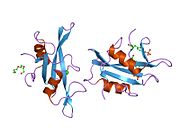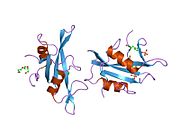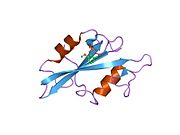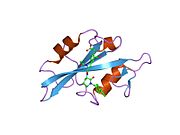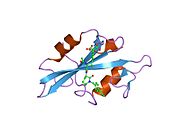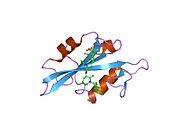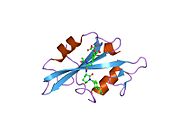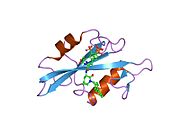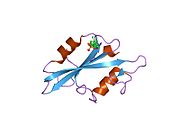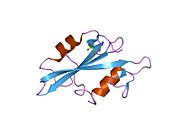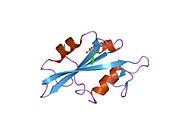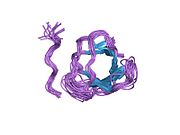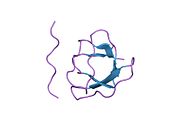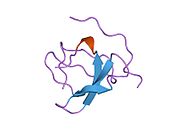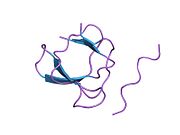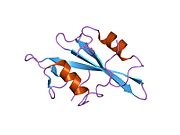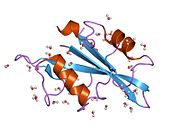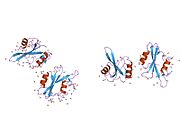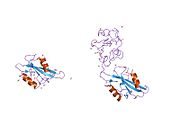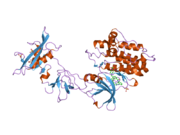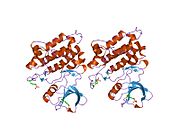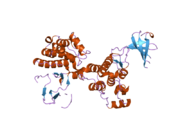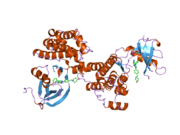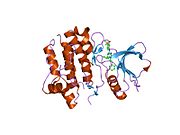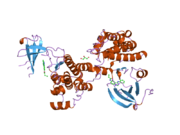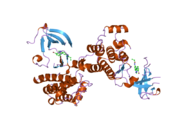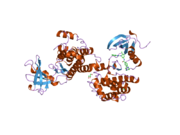1a07: C-SRC (SH2 DOMAIN) COMPLEXED WITH ACE-MALONYL TYR-GLU-(N,N-DIPENTYL AMINE)
1a08: C-SRC (SH2 DOMAIN) COMPLEXED WITH ACE-DIFLUORO PHOSPHOTYR-GLU-(N,N-DIPENTYL AMINE)
1a09: C-src (SH2 domain) complexed with ace-formyl phosphotyr-glu-(n,n-dipentyl amine)
1a1a: C-SRC (SH2 DOMAIN WITH C188A MUTATION) COMPLEXED WITH ACE-FORMYL PHOSPHOTYR-GLU-(N,N-DIPENTYL AMINE)
1a1b: C-SRC (SH2 DOMAIN) COMPLEXED WITH ACE-PHOSPHOTYR-GLU-(N,N-DIPENTYL AMINE)
1a1c: C-SRC (SH2 DOMAIN) COMPLEXED WITH ACE-PHOSPHOTYR-GLU-(N-ME(-(CH2)3-CYCLOPENTYL))
1a1e: C-SRC (SH2 DOMAIN) COMPLEXED WITH ACE-PHOSPHOTYR-GLU-(3-BUTYLPIPERIDINE)
1bkl: SELF-ASSOCIATED APO SRC SH2 DOMAIN
1bkm: COCRYSTAL STRUCTURE OF D-AMINO ACID SUBSTITUTED PHOSPHOPEPTIDE COMPLEX
1f1w: SRC SH2 THREF1TRP MUTANT COMPLEXED WITH THE PHOSPHOPEPTIDE S(PTR)VNVQN
1f2f: SRC SH2 THREF1TRP MUTANT
1fmk: CRYSTAL STRUCTURE OF HUMAN TYROSINE-PROTEIN KINASE C-SRC
1hcs: NMR STRUCTURE OF THE HUMAN SRC SH2 DOMAIN COMPLEX
1hct: NMR STRUCTURE OF THE HUMAN SRC SH2 DOMAIN COMPLEX
1is0: Crystal Structure of a Complex of the Src SH2 Domain with Conformationally Constrained Peptide Inhibitor
1kc2: structure of the triple (Lys(beta)D3Ala, Asp(beta)C8Ala, AspCD2Ala) mutant of the Src SH2 domain bound to the PQpYEEIPI peptide
1ksw: Structure of Human c-Src Tyrosine Kinase (Thr338Gly Mutant) in Complex with N6-benzyl ADP
1nlo: STRUCTURE OF SIGNAL TRANSDUCTION PROTEIN, NMR, MINIMIZED AVERAGE STRUCTURE
1nlp: STRUCTURE OF SIGNAL TRANSDUCTION PROTEIN, NMR, MINIMIZED AVERAGE STRUCTURE
1nzl: Crystal Structure of Src SH2 domain bound to doubly phosphorylated peptide PQpYEpYIPI
1nzv: Crystal Structure of Src SH2 domain bound to doubly phosphorylated peptide PQpYIpYVPA
1o41: CRYSTAL STRUCTURE OF SH2 IN COMPLEX WITH RU78300.
1o42: CRYSTAL STRUCTURE OF SH2 IN COMPLEX WITH RU81843.
1o43: CRYSTAL STRUCTURE OF SH2 IN COMPLEX WITH RU82129.
1o44: Crystal structure of sh2 in complex with ru85052
1o45: CRYSTAL STRUCTURE OF SH2 IN COMPLEX WITH RU84687.
1o46: CRYSTAL STRUCTURE OF SH2 IN COMPLEX WITH RU90395.
1o47: CRYSTAL STRUCTURE OF SH2 IN COMPLEX WITH RU82209.
1o48: CRYSTAL STRUCTURE OF SH2 IN COMPLEX WITH RU85053.
1o49: CRYSTAL STRUCTURE OF SH2 IN COMPLEX WITH RU85493.
1o4a: CRYSTAL STRUCTURE OF SH2 IN COMPLEX WITH RU82197.
1o4b: CRYSTAL STRUCTURE OF SH2 IN COMPLEX WITH RU83876.
1o4c: CRYSTAL STRUCTURE OF SH2 IN COMPLEX WITH PHOSPHATE.
1o4d: CRYSTAL STRUCTURE OF SH2 IN COMPLEX WITH RU78262.
1o4e: CRYSTAL STRUCTURE OF SH2 IN COMPLEX WITH RU78299.
1o4f: CRYSTAL STRUCTURE OF SH2 IN COMPLEX WITH RU79073.
1o4g: CRYSTAL STRUCTURE OF SH2 IN COMPLEX WITH DPI59.
1o4h: CRYSTAL STRUCTURE OF SH2 IN COMPLEX WITH RU79072.
1o4i: CRYSTAL STRUCTURE OF SH2 IN COMPLEX WITH PAS219.
1o4j: CRYSTAL STRUCTURE OF SH2 IN COMPLEX WITH ISO24.
1o4k: CRYSTAL STRUCTURE OF SH2 IN COMPLEX WITH PASBN.
1o4l: CRYSTAL STRUCTURE OF SH2 IN COMPLEX WITH FRAGMENT2.
1o4m: CRYSTAL STRUCTURE OF SH2 IN COMPLEX WITH MALONICACID.
1o4n: CRYSTAL STRUCTURE OF SH2 IN COMPLEX WITH OXALIC ACID.
1o4o: CRYSTAL STRUCTURE OF SH2 IN COMPLEX WITH PHENYLPHOSPHATE.
1o4p: CRYSTAL STRUCTURE OF SH2 IN COMPLEX WITH RU78791.
1o4q: CRYSTAL STRUCTURE OF SH2 IN COMPLEX WITH RU79256.
1o4r: CRYSTAL STRUCTURE OF SH2 IN COMPLEX WITH RU78783.
1p13: Crystal Structure of the Src SH2 Domain Complexed with Peptide (SDpYANFK)
1prl: TWO BINDING ORIENTATIONS FOR PEPTIDES TO SRC SH3 DOMAIN: DEVELOPMENT OF A GENERAL MODEL FOR SH3-LIGAND INTERACTIONS
1prm: TWO BINDING ORIENTATIONS FOR PEPTIDES TO SRC SH3 DOMAIN: DEVELOPMENT OF A GENERAL MODEL FOR SH3-LIGAND INTERACTIONS
1qwe: C-SRC SH3 DOMAIN COMPLEXED WITH LIGAND APP12
1qwf: C-SRC SH3 DOMAIN COMPLEXED WITH LIGAND VSL12
1rlp: TWO BINDING ORIENTATIONS FOR PEPTIDES TO SRC SH3 DOMAIN: DEVELOPMENT OF A GENERAL MODEL FOR SH3-LIGAND INTERACTIONS
1rlq: TWO BINDING ORIENTATIONS FOR PEPTIDES TO SRC SH3 DOMAIN: DEVELOPMENT OF A GENERAL MODEL FOR SH3-LIGAND INTERACTIONS
1sha: CRYSTAL STRUCTURE OF THE PHOSPHOTYROSINE RECOGNITION DOMAIN SH2 OF V-SRC COMPLEXED WITH TYROSINE-PHOSPHORYLATED PEPTIDES
1shb: CRYSTAL STRUCTURE OF THE PHOSPHOTYROSINE RECOGNITION DOMAIN SH2 OF V-SRC COMPLEXED WITH TYROSINE-PHOSPHORYLATED PEPTIDES
1shd: PEPTIDE INHIBITORS OF SRC SH3-SH2-PHOSPHOPROTEIN INTERACTIONS
1skj: COCRYSTAL STRUCTURE OF UREA-SUBSTITUTED PHOSPHOPEPTIDE COMPLEX
1spr: BINDING OF A HIGH AFFINITY PHOSPHOTYROSYL PEPTIDE TO THE SRC SH2 DOMAIN: CRYSTAL STRUCTURES OF THE COMPLEXED AND PEPTIDE-FREE FORMS
1sps: BINDING OF A HIGH AFFINITY PHOSPHOTYROSYL PEPTIDE TO THE SRC SH2 DOMAIN: CRYSTAL STRUCTURES OF THE COMPLEXED AND PEPTIDE-FREE FORMS
1srl: 1H AND 15N ASSIGNMENTS AND SECONDARY STRUCTURE OF THE SRC SH3 DOMAIN
1srm: 1H AND 15N ASSIGNMENTS AND SECONDARY STRUCTURE OF THE SRC SH3 DOMAIN
1y57: Structure of unphosphorylated c-Src in complex with an inhibitor
1yi6: C-term tail segment of human tyrosine kinase (258-533)
1yoj: Crystal structure of Src kinase domain
1yol: Crystal structure of Src kinase domain in complex with CGP77675
1yom: Crystal structure of Src kinase domain in complex with Purvalanol A
2bdf: Src kinase in complex with inhibitor AP23451
2bdj: Src kinase in complex with inhibitor AP23464
2h8h: Src kinase in complex with a quinazoline inhibitor
2hwo: Crystal structure of Src kinase domain in complex with covalent inhibitor
2hwp: Crystal structure of Src kinase domain in complex with covalent inhibitor PD168393
2oiq: Crystal Structure of chicken c-Src kinase domain in complex with the cancer drug imatinib.
2ptk: CHICKEN SRC TYROSINE KINASE
2src: CRYSTAL STRUCTURE OF HUMAN TYROSINE-PROTEIN KINASE C-SRC, IN COMPLEX WITH AMP-PNP























